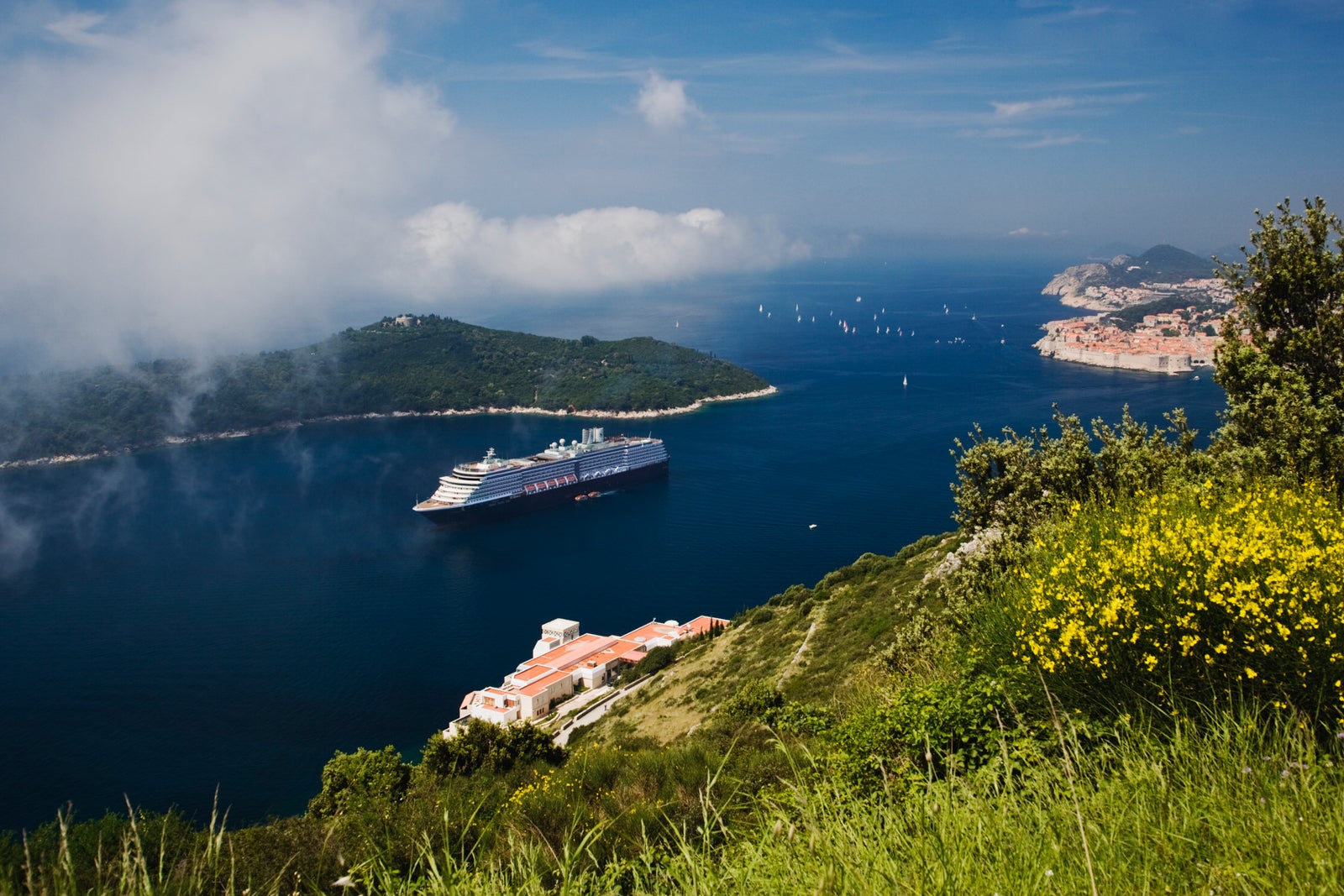No two Mediterranean cruises are the same. Some bring travelers to the French and Italian rivieras for food, wine and cultural pursuits. Others head east to the Greek islands, where passengers alternate days sipping ouzo at a beachfront taverna with trips to ancient sites. Each itinerary is a mix of urban tourist capitals — Barcelona! Rome! Istanbul! — and sleeper gems, such as Portofino, Italy, and Kotor, Montenegro.
If you’ve never been to Europe, you might feel overwhelmed by destination choices. If you know which ports are on your must-see list, you might be more stumped by which cruise line to choose or which specific itinerary will be the best for you.
For cruise news, reviews and tips, sign up for TPG’s cruise newsletter.
Know that you can’t see everything in one Mediterranean cruise — even on sailings that run multiple weeks. Once you let go of your need to see and do it all and accept that you’re on a sampler tour, you’ll be better able to make your cruise selections and enjoy the ports your ship does visit.
Get started on your journey with this Mediterranean cruise guide. You’ll learn the basics of itineraries, cruise lines, destinations, when to go and when to book your European adventure at sea.
Why cruise to the Mediterranean?
Many of the European countries on your travel bucket list lie along the Mediterranean Sea: Spain, France, Italy, Greece, Turkey, Israel and Egypt. A cruise lets you hit many of the hot spots (the French Riviera, Barcelona and Venice, Italy) on one trip without having to navigate multiple hotels, transportation between cities and dinner reservations in foreign languages.
For some people, those experiences are a key part of travel. However, for vacationers who want all the attractions without the hassle, a cruise is an ideal way to explore the Mediterranean. This type of European cruise can be especially alluring to honeymooners, families and older couples.
Mediterranean cruises beckon travelers with a love of culture and history. Visit the Parthenon in Athens, Greece, or the Colosseum in Rome; see Michelangelo’s David in Florence, Italy; or make a pilgrimage to the Hagia Sophia or Blue Mosque in Istanbul. Take a tour to a medieval town, or marvel at the construction of a soaring cathedral. If you’ve always wanted to see the ruins in Ephesus, Turkey, and Pompeii, Italy, Antoni Gaudí’s Sagrada Familia in Barcelona and the famous casino in Monaco, you can do it easily on a Mediterranean sailing.
You can also eat your way through the markets, cafes, trattorias, gelato shops and crepe stands in the ports you visit. Sample local wines at vineyards in France and Italy, or sip ouzo or limoncello made on the premises.

Daily Newsletter
Reward your inbox with the TPG Daily newsletter
Join over 700,000 readers for breaking news, in-depth guides and exclusive deals from TPG’s experts
When do cruises go to the Mediterranean?
You might be surprised to learn that cruise ships sail the Mediterranean year-round.
The majority of ships, however, arrive in spring and depart in fall, choosing warmer climes like the Caribbean for winter holiday sailings. Only a few hardy stalwarts remain through the colder months. Several of those are European-based lines, such as Costa Cruises and MSC Cruises, but Viking also braves chilly weather for its destination-focused itineraries in Europe.
Related: The best time to cruise the Mediterranean
Best Mediterranean itineraries
You can find a variety of weeklong Mediterranean cruises, but if you have the time, nine- to 14-night sailings are not uncommon. Seven-night cruises are best if you’re short on time or want to tack on a few days in Barcelona, Rome or Athens before or after your cruise. Longer itineraries are ideal for experiencing a greater variety of destinations and traversing more of the Med.
Here are some of the best Mediterranean cruise itineraries you should consider for your European vacation.
Related: Best Mediterranean cruises in 2024 and 2025
Western Mediterranean
The classic Western Mediterranean cruise sails between Barcelona and Rome and calls in ports in Spain, France, Monaco and Italy. This is your chance to explore Tuscany and the French Riviera, as well as hit up Florence; Monte Carlo, Monaco; Naples, Italy; and islands such as Corsica in France, Mallorca in Spain and Sicily and Sardinia in Italy. Just watch out: Marquee destinations like Rome and Florence are both located an hour or more from the cruise port, so get ready for long bus rides and long days off the ship.
Greece and Turkey
The classic Eastern Mediterranean cruise sails out of Athens or Istanbul and visits a mix of historic places (Delphi, Greece; Ephesus via Kusadasi, Turkey; the Greek island of Rhodes) and sun-drenched islands (Mykonos and Santorini, Greece).
Adriatic Sea
Some so-called Mediterranean cruises actually spend most of their time on the Adriatic Sea, sailing from Venice and visiting ports in Croatia and Greece, and sometimes Montenegro and Albania. You might also find an Adriatic sailing wrapped into longer Western or Eastern Mediterranean cruises.
Holy Land
The most easterly of the Eastern Mediterranean itineraries, Holy Land cruises spend time in Israel and sometimes Egypt, often with overnight stops or multiple days spent in each country to maximize touring opportunities. These sailings might also call on Cyprus or ports in Greece and Turkey.
Due to the war in Gaza, the majority of cruise lines are not calling on ports in Israel in 2024. Some have also scrapped calls to ports in Egypt and Jordan.
Best Mediterranean cruise lines
Most major cruise lines send at least one ship to the Mediterranean every year. Even Carnival Cruise Line, known for its affordable cruises out of U.S. home ports, offers some Mediterranean sailings, as does Disney Cruise Line, which typically bases its ships near its theme parks.
If you’re looking for a bigger ship, Celebrity Cruises, Norwegian Cruise Line and Royal Caribbean are the best choices, as they base a handful of ships in the Mediterranean each year, arriving in spring and departing in fall. These lines offer a variety of itinerary choices, so you can find the Mediterranean ports you most want to visit. You’ll also find lots of restaurant choices and evening entertainment options to keep you occupied at night when the ship is sailing.
For a more international vibe on board, try MSC Cruises, a European cruise line that offers a great variety of ships and itineraries in the Mediterranean.
Couples or families with grown children looking for longer sailings and a destination focus should consider Viking. It offers eight- to 15-night cruises through the Mediterranean, including three- and four-week voyages for retirees (or digital nomads) who have time for a thorough exploration of the region.
Which luxury line is best for your Mediterranean cruise will depend on your preferences for a European itinerary and ship amenities and style. However, Regent Seven Seas Cruises and Silversea Cruises stand out for including a wide variety of shore excursions in their cruise fares. If you’re a foodie, these two lines, plus Oceania Cruises, are notable for their culinary tours in port and destination-themed cooking classes on board.
Things to do in the Mediterranean
Sightseeing is a big component of Mediterranean cruises, whether that’s exploring a historic site like the Roman Forum or the walled city of Dubrovnik, Croatia; visiting cathedrals in Florence and Barcelona; or touring medieval villages, forts and old towns. You might want to skip the formal tours and merely wander around the port town, browsing local shops or grabbing a coffee or snack in a local cafe.
Culinary tours are also popular here. You can choose from roving food tours, cooking classes, winery visits and tastings, and meals made with local produce and cheeses in beautiful villa or farmhouse settings.
Travelers looking to stretch their legs might want to sign up for cycling tours in city and country settings, hike around a volcano on Santorini or Sicily, or even take a kayak for a spin in Croatia or Greece.
A beach day is possible in the Greek islands or along the French Riviera, and many ports will have sightseeing cruises.
Related: Best Mediterranean cruise shore excursions
Best Mediterranean cruise ports
Everyone has their favorite list of the best Mediterranean cruise ports. Some travelers want to hit all the most popular cities, while others prioritize the ability to walk right off the ship into the heart of the town. Some ports are better for historical attractions, others for cafe culture or outdoor activities.
The following cruise ports are generally standouts, no matter your travel style.
Barcelona: Both an embarkation port and a port of call, depending on your itinerary, Barcelona has much to offer first-timers and repeat visitors. Cruise ships dock at the end of Las Ramblas, the main thoroughfare in the old part of the city, so it’s easy to leave the ship and simply wander. Don’t miss Gaudí’s fantastical buildings or a meal of tapas.
Monte Carlo: Monte Carlo is both a fascinating port on its own and a gateway to the French Riviera. In town, you can walk to the casino, palace and stunning oceanographic museum. From town, you can take the twisty-turny Corniche coastal roads to destinations like Nice, Eze, Cannes and Grasse, France.
Dubrovnik: Even if you’re not in it for the “Game of Thrones” tour, you will be captivated by Dubrovnik and its famous walled city. Walk the walls or take to the water for scenic views of the Old Town.
Rome: It’s actually a pain to get to Rome from the cruise port of Civitavecchia by bus or train, but it’s worth it to experience the Eternal City firsthand. Tour the Vatican and Sistine Chapel at St. Peter’s Cathedral, step back in time at the Colosseum and Roman Forum, climb the Spanish Steps, throw a coin in the Trevi Fountain and meander through the Borghese Gardens. When your feet give out, take a breather with a gelato or plate of pasta.
Rhodes: The historic port of Rhodes no longer has a Colossus, but that doesn’t take away its appeal. Ensconced within ancient stone walls, the island’s Old Town is easily walkable, composed of cobblestone streets lined with restaurants and stores housed in structures dating back to the 14th century. If shopping isn’t your thing, keep walking until you reach the Palace of the Grand Master of the Knights of Rhodes, where you can take a tour, or venture out to one of the city’s beaches.
Naples: Naples is one of our favorite ports because you have so many options for things to do. It’s the jumping-off point for Italy tours to Pompeii, Mount Vesuvius, Capri and the Amalfi Coast. Or, if you want to explore the city on your own, perhaps sitting down to a lunch of the region’s famous pizza, it’s a quick walk right into town from your cruise ship.
Istanbul: Istanbul is the vibrant city you might not know you need to visit. Serving as both a departure port and port of call on Mediterranean cruises, the city offers something for everyone: the cultural icons of the Hagia Sophia and Blue Mosque, intense shopping experiences at the Grand Bazaar, Byzantine palaces, traditional Turkish baths (called hammams), flavorful cuisine, Bosporus day cruises between Europe and Asia and plenty of neighborhoods to explore.
Related: Best Mediterranean cruise tips to enhance your European vacation
When to book a Mediterranean cruise
It’s a good idea to book your Mediterranean cruise early, even nine to 12 months in advance. You can take advantage of early booking discounts and promotions and have the widest selection of available cabins and suites and dining times (if applicable). An early booking is ideal if you’re planning on using miles to book your flights or points for a precruise hotel. Look for fall sales when the current Mediterranean season is winding down.
Another smart time to book a Mediterranean cruise is during January or February when cruise lines run their wave season sales, often with extra freebies thrown into the cost of the sailing. You might find last-minute deals on spring cruises to Europe or still be considered early for fall itineraries.
Related: When is the best time to book a cruise?
What to bring on a Mediterranean cruise
The Mediterranean region has a temperate climate, but it still gets chilly in spring and fall and can be brutally hot in summer. Check the weather before your sail date, and pack for the predicted temperatures — with layers, in case the forecasters are wrong and it’s unseasonably hot or cold.
You’ll likely do a good deal of walking on a Mediterranean cruise, so a good pair of walking shoes is a must. Bonus if you can find cute options you can wear on sea days or sneakers that can do double duty in the ship’s gym.
If your tours take you to religious sites, you might need a modest outfit that covers shoulders, arms and knees. Ladies, a shawl is a versatile option you can toss over your shoulders (or hair, if need be), use for warmth with your strappy formal night attire or wear as a blanket on the airplane.
Of course, North Americans taking Mediterranean cruise vacations will need a passport to fly to and from their ship’s departure and arrival ports.
Related: Mediterranean cruise packing list: What to pack when cruising Europe
Bottom line
The Mediterranean is an amazing region to cruise, and a sailing there is a wonderful introduction to Europe for travelers who have never been. The varied choices of itineraries, cruise lines and ships can be intimidating, but rest assured, you can’t really go wrong with any of them. Just know that once you go, you might feel a need to return — either to see a port you loved more in-depth on a land vacation or to sail to the Mediterranean countries you missed on your first go-round.
Planning a cruise? Start with these stories:








